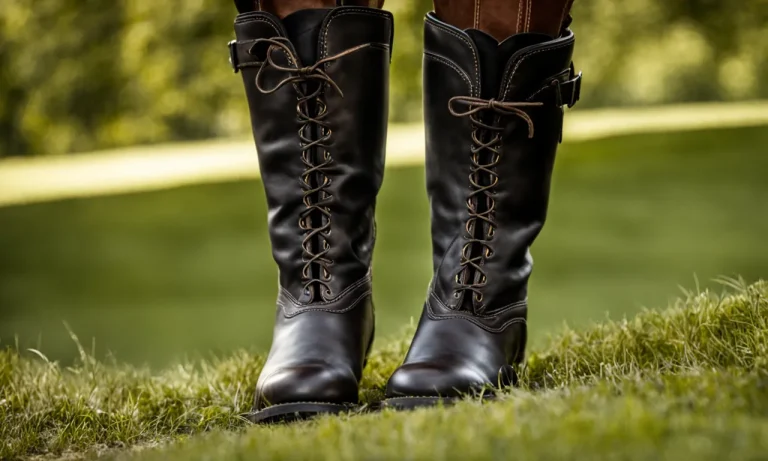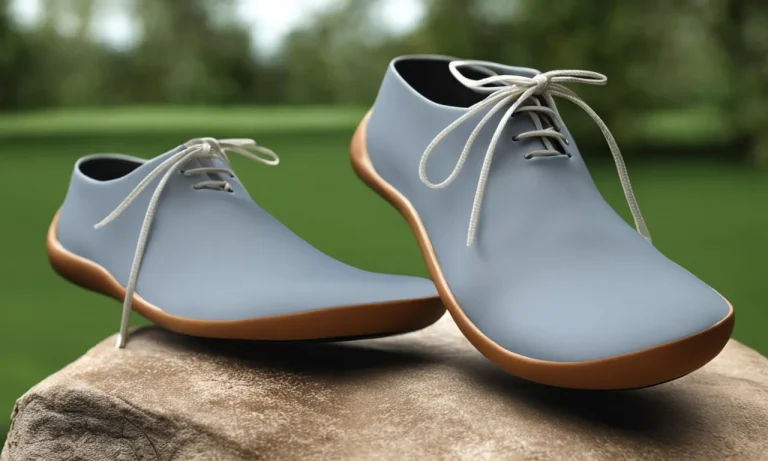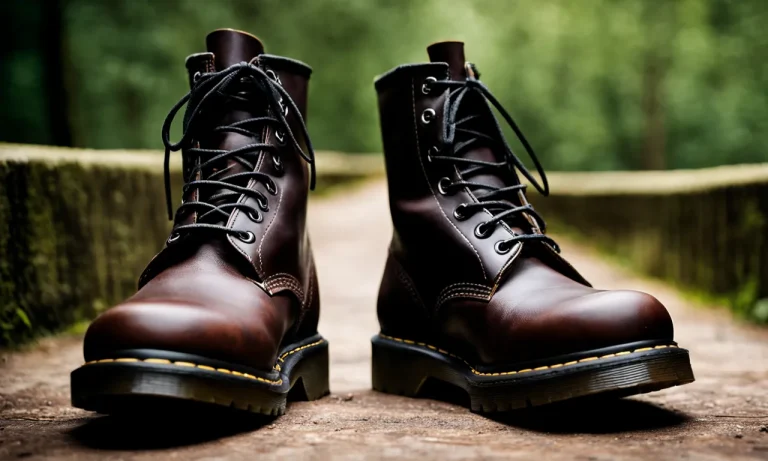If you’ve ever worn through the inside of your favorite pair of shoes, you know how frustrating it can be. The inside sole wears down over time with use, causing discomfort or even exposing your foot to the ground.
Thankfully, there are ways to fix the inside of a shoe fairly easily and restore its comfort.
If you’re short on time, here’s a quick answer to your question: You can fix the inside of a shoe by gluing a new insole in place, using shoe repair glue and an insole insert. Read on for more details.
In this comprehensive guide, we’ll cover everything you need to know about repairing the inside of worn-out shoes. We’ll go over the step-by-step process, including how to prepare the shoe, choose the right materials like insoles and adhesives, properly install the new insole, and care for your newly repaired shoes.
Assess the Damage and Prepare the Shoe
Before attempting to fix the inside of a shoe, it is important to assess the damage and prepare the shoe accordingly. This will ensure that the repair process is effective and long-lasting. There are several steps involved in this preparation process.
Inspect the Inside and Determine the Extent of Wear
The first step is to carefully inspect the inside of the shoe and determine the extent of wear. Look for any signs of damage such as holes, tears, or worn-out linings. This will help you understand what needs to be fixed and the materials that will be required for the repair.
If you notice any major structural damage, it may be necessary to consult a professional cobbler who can provide expert advice and assistance. They have the skills and experience to handle complex repairs and ensure the shoe is restored to its original condition.
Thoroughly Clean the Interior
Once you have assessed the damage, the next step is to thoroughly clean the interior of the shoe. Use a soft brush or cloth to remove any dirt, dust, or debris that may have accumulated over time. Pay special attention to the areas around the toe box and the heel, as these tend to collect more dirt.
If the shoe has a removable insole or lining, take it out and clean it separately. This will help eliminate any unpleasant odors and ensure a fresh start for the shoe. You can use a mild soap or a specialized shoe cleaner to clean the interior, but make sure to read the instructions carefully and test it on a small, inconspicuous area first.
Remove Old Linings or Insoles if Needed
If the linings or insoles of the shoe are severely worn out or damaged, it may be necessary to remove them completely. This will create a clean canvas for any repairs or replacements that need to be done. Carefully detach the old linings or insoles, taking care not to damage the shoe’s structure.
Once the old linings or insoles are removed, you can either replace them with new ones or opt for alternative solutions such as gel inserts or cushioning pads. The choice will depend on the specific needs of your foot and the level of comfort you desire.
Consult a professional if you are unsure about the best course of action.
By assessing the damage and preparing the shoe properly, you are setting the stage for successful repairs and ensuring the longevity of your footwear. Taking the time to inspect, clean, and remove old linings or insoles if needed will help you achieve the best possible results.
Select the Right Replacement Insole
Measure for Proper Fit
When replacing the insole of your shoe, it is important to measure for proper fit. This will ensure that the replacement insole fits comfortably and provides the necessary support. To measure, remove the old insole and place it on a flat surface. Then, trace around it with a pen or pencil.
Use these measurements as a guide when selecting a replacement insole. Keep in mind that some insoles may need to be trimmed down to fit perfectly.
Choose Material Based on Use
When selecting a replacement insole, consider the material based on the intended use of the shoe. For everyday shoes, such as sneakers or dress shoes, a cushioned or memory foam insole may provide the most comfort.
For athletic shoes, a gel or shock-absorbing insole can help reduce impact during physical activities. If you have specific foot conditions, such as plantar fasciitis or flat feet, look for insoles designed to address these issues.
Consider Arch Support Needs
Arch support is important for maintaining proper foot alignment and preventing discomfort or pain. When choosing a replacement insole, consider your arch support needs. If you have high arches, look for insoles with built-in arch support or opt for customizable insoles that allow you to adjust the support to your liking.
If you have flat feet, choose insoles with extra arch support to provide the necessary stability.
Opt for Moisture-Wicking Fabric if Needed
If you frequently experience sweaty feet or plan to use the shoes in humid or wet conditions, it is recommended to opt for replacement insoles made from moisture-wicking fabric. These insoles help to absorb and evaporate moisture, keeping your feet dry and comfortable.
Look for materials like bamboo charcoal or anti-microbial fabrics, as they can also help prevent odor-causing bacteria from forming.
Pick the Proper Adhesive
When it comes to fixing the inside of a shoe, choosing the right adhesive is crucial. Using the wrong adhesive can result in a weak bond that won’t last long. Here are three types of adhesives that are commonly used for shoe repair:
Shoe Repair Glue
Shoe repair glue is specifically designed for fixing shoes. It is a strong adhesive that forms a durable bond and can withstand wear and tear. This type of glue is often used to repair soles, heels, and other parts of the shoe that have come apart.
Shoe repair glue is available in both liquid and gel forms, allowing you to choose the consistency that works best for your repair needs. One popular brand of shoe repair glue is Barge All-Purpose Cement, which is known for its strong hold and flexibility.
Contact Cement
Contact cement is another adhesive that is commonly used for shoe repair. It is a strong, fast-drying adhesive that forms an instant bond when two surfaces are pressed together. Contact cement is ideal for repairing shoe linings, insoles, and other areas where a strong bond is needed.
It is important to follow the instructions carefully when using contact cement, as it typically requires both surfaces to be coated and allowed to dry before they can be bonded together. One well-known brand of contact cement is DAP Weldwood Original Contact Cement.
Rubber Cement
Rubber cement is a versatile adhesive that can be used for a variety of shoe repairs. It is a flexible adhesive that forms a temporary bond, allowing you to easily reposition the materials if needed. Rubber cement is often used for attaching insoles, padding, and other materials to the inside of a shoe.
It is important to note that rubber cement is not as strong as shoe repair glue or contact cement, so it may not be suitable for repairs that require a long-lasting bond. One popular brand of rubber cement is Elmer’s CraftBond Rubber Cement.
When choosing an adhesive, consider the specific repair needs of your shoe and select the adhesive that will provide the strongest and most durable bond. It is also important to read and follow the instructions provided by the adhesive manufacturer to ensure proper application and bonding.
Install the New Insole
When it comes to fixing the inside of a shoe, installing a new insole is an essential step. A worn-out or uncomfortable insole can greatly affect the comfort and support of a shoe. By replacing it with a new one, you can restore the shoe’s original comfort and provide proper support for your feet.
Apply the Adhesive Properly
Before installing the new insole, it is important to apply the adhesive properly. The adhesive ensures that the insole stays in place and doesn’t move around while you’re wearing the shoe. Make sure to read the instructions on the adhesive carefully and apply it evenly on the bottom surface of the insole.
Pro tip: Applying too much adhesive can cause it to seep through the insole and make it uncomfortable to wear. Use a small amount of adhesive and spread it evenly to avoid this issue.
Press the Insole Firmly into Place
Once you have applied the adhesive, carefully place the new insole inside the shoe. Align it properly with the shape of the shoe and press it firmly into place. Applying firm pressure helps the adhesive bond effectively with the shoe’s interior.
Make sure there are no air bubbles or wrinkles under the insole.
Pro tip: If the insole is slightly larger than the shoe, you can trim it down to fit perfectly. Use a pair of scissors to cut along the edges, ensuring a clean and precise fit.
Allow Time to Dry Thoroughly
After pressing the insole into place, it’s crucial to allow sufficient drying time. This allows the adhesive to bond securely with both the insole and the shoe. Keeping the shoe in a well-ventilated area and allowing ample time for drying will ensure a long-lasting fix.
Pro tip: It is recommended to let the shoe dry for at least 24 hours before wearing it. This gives the adhesive enough time to set and ensures that the insole stays in place while walking or running.
By following these steps and properly installing a new insole, you can easily fix the inside of a shoe and restore its comfort and support. Remember, a well-maintained shoe not only enhances your walking experience but also prolongs the lifespan of the shoe itself.
Care for the Repaired Shoes
Once you have successfully fixed the inside of your shoes, it is important to take proper care of them to ensure their longevity and continued comfort. Here are some tips to help you care for your repaired shoes:
Let Shoes Completely Dry Before Wearing
After any repair work, it is crucial to allow your shoes to thoroughly dry before wearing them again. This is especially important if you had to use any adhesives or waterproofing products during the repair process. Moisture trapped inside the shoe can lead to mold growth and unpleasant odors.
To speed up the drying process, you can place your shoes in a well-ventilated area or use a shoe dryer. Remember, patience is key to maintaining the quality and integrity of your repaired shoes.
Consider Waterproofing Sprays or Creams
To protect your repaired shoes from water damage, it is a good idea to consider using waterproofing sprays or creams. These products create a protective barrier that repels water, preventing it from seeping into the shoe’s material.
Before applying any waterproofing product, make sure to clean your shoes thoroughly and follow the manufacturer’s instructions. Waterproofing can significantly extend the lifespan of your shoes while keeping your feet dry and comfortable, even in wet conditions.
Watch for Wear and Tear
Regularly inspect your repaired shoes for any signs of wear and tear. Even with proper repair, shoes can still develop weak spots or new areas of damage over time. Look out for loose stitching, sole separation, or any other issues that may compromise the integrity of the shoe.
By catching these problems early on, you can prevent further damage and address them promptly. If you notice any significant issues, it may be necessary to seek professional repair or consider replacing the shoes altogether.
Remember, taking care of your repaired shoes is just as important as the repair itself. By following these tips, you can ensure that your shoes stay in great condition and continue to provide you with comfort and style for a long time to come.
Conclusion
With the right materials and a little DIY spirit, you can easily give your favorite shoes new life by repairing the insides. Following the proper process of cleaning, preparing, gluing, and inserting a fresh insole can restore comfort and add miles of wear to your well-loved footwear.
Just be sure to select durable materials and allow time for thorough drying so your repair lasts. With a few inexpensive supplies and a little time invested, you can save money compared to the cost of replacement shoes and reduce waste, giving your feet happy mileage in your favorite shoes.






